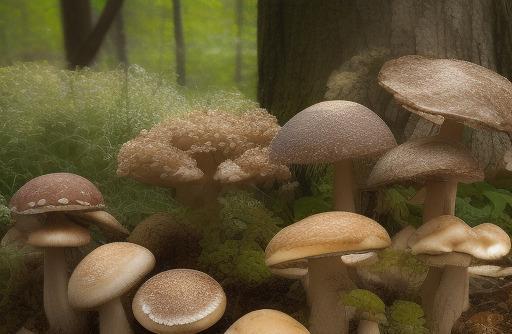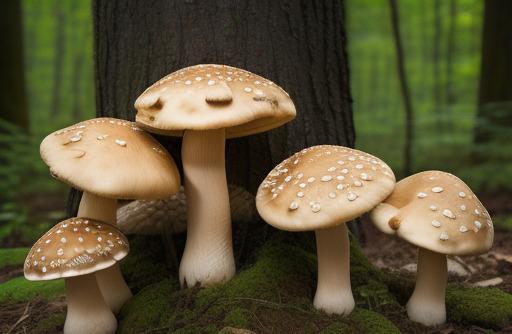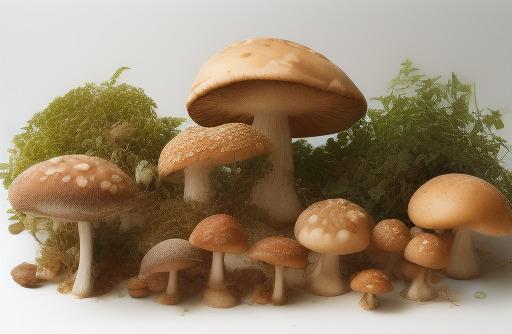- You are here:
- Home »
- Food Substitutes
- » Best Substitutes For Mushrooms
Best Substitutes For Mushrooms

Mushrooms are a versatile ingredient that can add a burst of earthy flavors to various dishes. However, there may be times when you need to find a substitute for mushrooms due to dietary restrictions, allergies, or simply because you don’t have any on hand. Luckily, there are several ingredients that can mimic the taste and texture of mushrooms, allowing you to still enjoy flavorful dishes. In this article, we will explore the best substitutes for mushrooms and how to use them in your cooking.
Key Takeaways
- If you need to substitute mushrooms in a recipe, consider the flavor profile and texture you’re trying to achieve.
- Some of the best substitutes for mushrooms include eggplant, tofu, zucchini, and beans.
- Choosing the right substitute depends on your personal preferences and the dish you’re making.
- Different substitutes may require slight changes in cooking methods or seasoning to achieve the desired result.
Why You Need A Substitute For Mushrooms
There are several reasons why you might need to find a substitute for mushrooms. These include:
-
Allergies or Dietary Restrictions: Some individuals may have allergies to mushrooms or follow specific dietary restrictions that prohibit the consumption of mushrooms. In such cases, finding suitable substitutes is essential to avoid any adverse reactions.
-
Unavailable or Seasonal: Mushrooms may not be available all year round or may be difficult to find in certain regions. If you can’t find fresh or good quality mushrooms, having substitutes on hand can save the day.
-
Variety: Sometimes you may want to experiment with different flavors and textures. By using substitutes, you can create unique dishes that deviate from the traditional mushroom taste.
Types Of Substitutes For Mushrooms

When looking for substitutes for mushrooms, it’s important to consider the texture and flavor profile you’re trying to achieve. Some common types of substitutes for mushrooms include:
-
Vegetables: Certain vegetables can provide a similar texture and flavor to mushrooms when cooked. These include eggplant, zucchini, and Portobello mushroom stems.
-
Protein Alternatives: Tofu, tempeh, and seitan are popular substitutes for mushrooms, especially in vegan or vegetarian recipes. These options provide a meaty texture and absorb flavors well.
-
Legumes: Beans, lentils, and chickpeas can be used as substitutes for a meaty texture similar to mushrooms. These alternatives provide a good source of protein and fiber.
-
Grains: Some grains, such as barley or quinoa, can mimic the texture of cooked mushrooms. These can be used as a substitute when mushrooms are called for in recipes like stews, risottos, or grain bowls.
-
Mushroom Extracts: If you’re looking to replicate the umami flavor of mushrooms, mushroom extracts or powders can be used as substitutes. These concentrated forms of mushrooms add depth and richness to dishes.
Best Substitutes For Mushrooms

Now that we’ve explored the different types of substitutes, let’s take a closer look at some of the best alternatives for mushrooms:
1. Eggplant
Eggplant is an excellent substitute for mushrooms, especially when you want to mimic their meaty texture. When cooked, eggplant becomes tender and absorbs flavors well. To use eggplant as a substitute for mushrooms, simply chop it into similar-sized pieces and cook it in the same way as you would cook mushrooms.
2. Tofu
Tofu is a versatile ingredient and can be used in many dishes as a substitute for mushrooms. It has a soft and spongy texture that can absorb flavors easily, making it a great choice for stir-fries, curries, or soups. To use tofu as a substitute, drain and press it to remove excess moisture, and then cook it the same way you would cook mushrooms.
3. Zucchini
Zucchini is another vegetable that can be used as a substitute for mushrooms. It has a mild flavor and a slightly crunchy texture when cooked. Zucchini works particularly well in dishes like stir-fries, pasta sauces, or fajitas. To use zucchini as a substitute, slice it into thin rounds or sticks and cook it until it reaches the desired tenderness.
4. Beans
Beans, such as black beans, kidney beans, or cannellini beans, can provide a meaty texture and protein content similar to mushrooms. They are a perfect substitute for dishes like chili, tacos, or stews. You can use canned or cooked beans in place of mushrooms, simply adjusting the cooking time accordingly.
5. Portobello Mushroom Stems
If you have Portobello mushrooms, but the caps are reserved for another recipe, don’t discard the stems! Portobello mushroom stems can be used as a substitute for other mushrooms in many recipes. They have a similar flavor, texture, and earthy aroma that can enhance your dishes.
Pro Tip:
To mimic the unique umami flavor of mushrooms, add some soy sauce or tamari to your substitute ingredient. These sauces contain natural glutamates, which can enhance the savory taste of your dish.
Choosing The Right Substitute For Mushrooms

When selecting a substitute for mushrooms, you should consider the following factors:
-
Flavor: Mushrooms have a distinct earthy and umami flavor. Choose a substitute that complements the other ingredients in your recipe and provides a similar depth of flavor.
-
Texture: Mushrooms have a meaty texture that can be replicated using substitutes like tofu, eggplant, or beans. Consider the texture you want in your dish and select a substitute accordingly.
-
Cooking Method: Some substitutes may require slight adjustments in cooking methods. For example, zucchini cooks relatively quickly, while beans may need to be simmered for a longer time. Be mindful of the cooking times suggested for your chosen substitute.
-
Personal Preferences: Ultimately, the choice of a substitute depends on your personal preferences. Experiment with different substitutes to find the ones you enjoy the most.
Cooking With Substitutes For Mushrooms

When cooking with substitutes for mushrooms, here are a few tips to keep in mind:
-
Preparation: Properly prepare your substitute ingredient before cooking to ensure the best texture and flavor. For example, drain and press tofu, slice zucchini into uniform pieces, or cook beans until tender.
-
Seasoning: To mimic the umami flavor of mushrooms, add condiments such as soy sauce, tamari, or mushroom extracts to your dish. These additions will enhance the savory taste and provide depth.
-
Cooking Time: Some substitutes may require different cooking times compared to mushrooms. Adjust the cooking time accordingly and be mindful of the texture you want to achieve.
-
Experiment: Don’t be afraid to experiment with different substitutes and cooking methods. This will help you discover unique flavors and create dishes tailored to your liking.
Recipes Using Substitutes For Mushrooms

Here are a few recipes that utilize substitutes for mushrooms:
1. Tofu And Vegetable Stir-Fry
Ingredients:
- 1 block of tofu, drained and pressed
- 2 tablespoons soy sauce
- 1 tablespoon sesame oil
- 1 tablespoon vegetable oil
- 1 bell pepper, sliced
- 1 zucchini, sliced
- 1 carrot, julienned
- 1 cup snap peas
- 2 cloves garlic, minced
- 1 teaspoon grated ginger
Instructions:
- Cut the tofu into cubes and marinate with soy sauce for 10 minutes.
- Heat vegetable oil in a wok or frying pan and add tofu. Cook until slightly crispy.
- Remove tofu from the pan and set aside.
- In the same pan, add sesame oil and sauté garlic and ginger for a minute.
- Add the vegetables and stir-fry until tender-crisp.
- Return tofu to the pan and toss to combine with the vegetables.
- Serve hot with steamed rice or noodles.
2. Eggplant, Tomato, And Mozzarella Skewers
Ingredients:
- 1 large eggplant, cut into cubes
- 1 cup cherry tomatoes
- 1 ball of mozzarella, cut into cubes
- 2 tablespoons olive oil
- 2 cloves garlic, minced
- Salt and pepper, to taste
- Fresh basil leaves, for garnish
Instructions:
- Preheat the oven to 400°F (200°C).
- Place the eggplant cubes in a colander and sprinkle them with salt. Let them sit for 30 minutes to remove excess moisture.
- Rinse the eggplant cubes and pat them dry with a clean towel.
- In a bowl, combine the eggplant, cherry tomatoes, minced garlic, olive oil, salt, and pepper. Toss until well-coated.
- Thread the eggplant, tomato, and mozzarella cubes onto skewers.
- Place the skewers on a baking sheet and roast in the oven for 15-20 minutes, or until the vegetables are tender and slightly charred.
- Garnish with fresh basil leaves before serving.
Pro Tip:
When cooking with substitutes for mushrooms, consider the cooking time and adjust it accordingly. For example, zucchini cooks faster than mushrooms, so it’s essential to keep an eye on it to avoid overcooking.
Storage And Shelf Life Of Substitutes

The storage and shelf life of substitutes for mushrooms may vary depending on the ingredient:
-
Tofu: Store tofu in the refrigerator, submerged in water, and change the water daily. It can last for up to one week. Once cooked, store any leftovers in an airtight container in the refrigerator for up to three days.
-
Eggplant: Store whole eggplants in a cool, dry place away from direct sunlight. Once cut, wrap the sliced eggplant tightly with plastic wrap or store it in an airtight container in the refrigerator. It can last for up to five days.
-
Zucchini: Store zucchini in the refrigerator, unwashed and wrapped in a plastic bag, for up to one week. Cut zucchini should be stored in an airtight container and used within three to four days.
-
Beans: Canned beans should be stored in a cool, dry place and consumed before the expiration date on the can. Cooked beans can be stored in an airtight container in the refrigerator for up to four days.
-
Mushroom Extracts: Mushroom extracts and powders can be stored in a cool, dry place, away from direct sunlight. Follow the instructions on the packaging for the shelf life of the specific product.
Conclusion
Finding suitable substitutes for mushrooms can open up a world of possibilities in your cooking. Whether you have dietary restrictions, allergies, or simply want to experiment with different flavors, there are plenty of options to choose from. By considering the flavor, texture, and cooking methods, you can find the perfect substitute that suits your needs. So, don’t be afraid to get creative in the kitchen and try out new ingredients. You might discover a whole new set of flavors and dishes along the way!
FAQS
What Are Some Common Alternatives To Mushrooms In Recipes?
Some common mushroom substitutes include eggplant, zucchini, bell peppers, and tofu. These options can often emulate the texture and taste of mushrooms in dishes such as stir-fries, soups, and stews. Additionally, other types of fungi such as oyster or shiitake mushrooms can offer a similar flavor profile to their common button mushroom counterpart.
Are There Any Health Benefits To Using Mushroom Substitutes?
While mushrooms are a nutrient-dense food, many of the substitutes offer their own health benefits. For example, eggplant is a good source of fiber and vitamin C, while zucchini offers vitamins A and C as well as potassium. Bell peppers are high in antioxidants and vitamin C, and tofu offers a protein-rich option for vegetarian and vegan dishes.
Can I Use These Substitutes In All Mushroom Recipes?
While many dishes that call for mushrooms can be easily swapped with alternatives, some recipes may require the unique taste or texture of mushrooms. For example, a mushroom sauce may be difficult to replicate without the distinct earthy flavor of mushrooms. It’s best to experiment with different substitutes and see what works best for each individual recipe.
How Do I Properly Cook And Prepare Mushroom Substitutes?
The cooking method and preparation will vary depending on the substitute being used. For example, slicing and lightly sautéing zucchini can emulate the texture of mushrooms, while baking or grilling tofu can give it a firmer texture. It’s important to note that some substitutes may require longer cooking times or different methods than mushrooms, so recipes may need to be adapted accordingly.
Are There Any Substitutes That Can’t Replace Mushrooms In Recipes?
While many fruits and vegetables can offer similar flavors and textures to mushrooms, there are some recipes that may be difficult to replicate without actual mushrooms. For example, mushroom risotto may be difficult to recreate with a different vegetable due to the unique umami flavor of mushrooms. However, with experimentation and creativity, many dishes that call for mushrooms can be successfully adapted to accommodate alternative substitutes.
Sources
About the Author Jenny
I'm Jenny, a housewife with an unwavering passion for food. My culinary journey began with my grandmother's kitchen, and it's now a full-fledged food blog. I've turned my love for cooking into a creative outlet, sharing recipes and stories with a global community of fellow food enthusiasts. It's proof that being a housewife can also mean pursuing your passions and savoring life's delectable moments.
